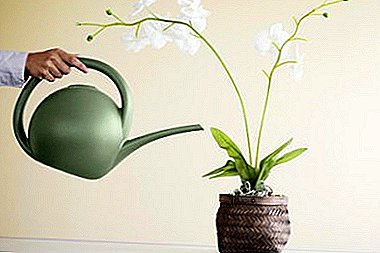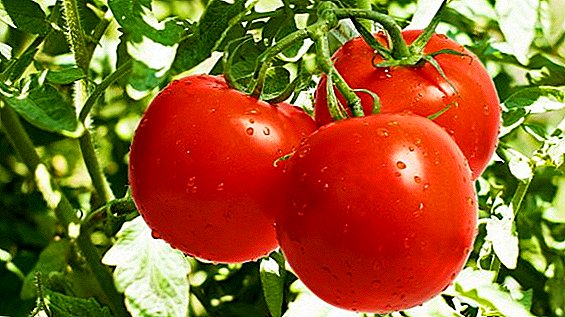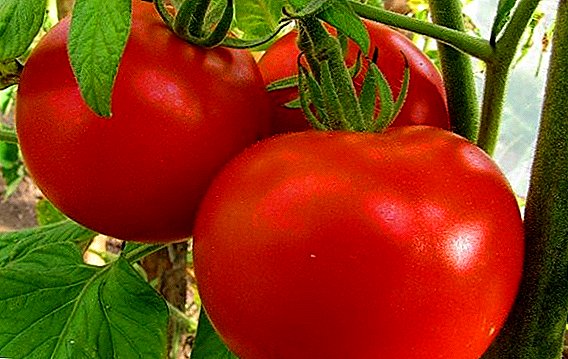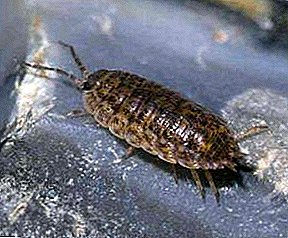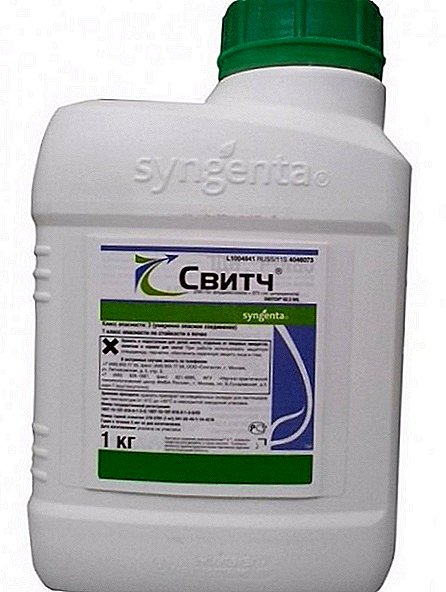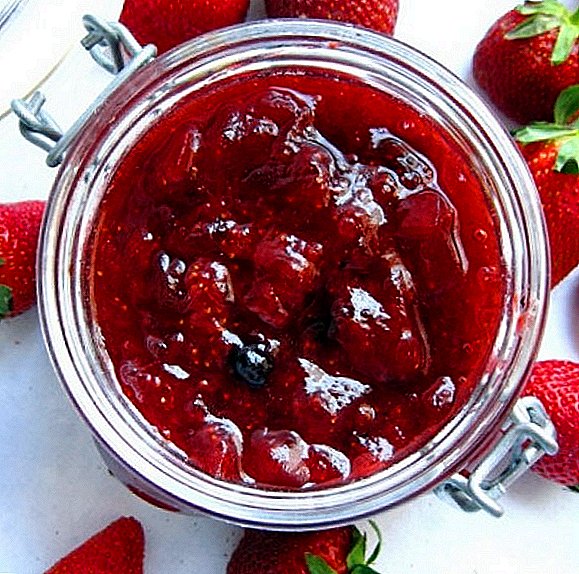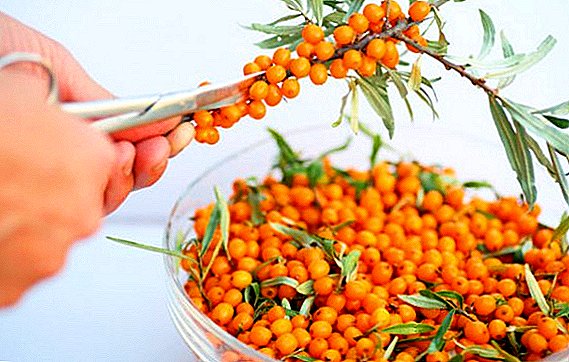 Sea buckthorn is a unique plant, the fruits of which are composed of a whole complex of vitamins and minerals. Sea buckthorn berries are saturated with organic acids, fiber, phytoncides and tannins. All this cemented the glory of a natural multivitamin remedy to the plant.
Sea buckthorn is a unique plant, the fruits of which are composed of a whole complex of vitamins and minerals. Sea buckthorn berries are saturated with organic acids, fiber, phytoncides and tannins. All this cemented the glory of a natural multivitamin remedy to the plant.
Brief description of the plant
Sea buckthorn (Latin name Hippophae) is a plant belonging to the Lokhov family. Trees or shrubs are covered with thorns and reach 0.1-3 meters in height (in some cases the plant can reach a height of 15 meters).  It has narrow, long leaves of green color. On top of the sheet is covered with a small speck, the lower part has a grayish-white, sometimes golden tint.
It has narrow, long leaves of green color. On top of the sheet is covered with a small speck, the lower part has a grayish-white, sometimes golden tint.
Sea buckthorn fruits are bright orange berries that have a spherical or elongated shape. Fruits cover branches rather thickly, literally clinging to them (hence the Russian-language name of the plant appeared). The fruit ripening period covers the end of August - the beginning of September. Even over-ripe berries are not showered and can hang all winter on the branches.
Did you know? Tibetan medicine highly appreciates the healing properties of this plant, which is called the "miracle berry". Not only fruits, but also leaves, flowers, roots and bark are used.
Calorie and composition
The rich composition of vitamins - this is what is the use of sea buckthorn. The plant contains the following vitamins:
- A (carotene);
- C (ascorbic acid);
- B1 (thiamine);
- B2 (riboflavin);
- B9 (folic acid);
- E (tocopherol);
- TO;
- R.
 Together with them there are minerals in the composition:
Together with them there are minerals in the composition:- magnesium;
- manganese;
- boron;
- iron;
- sulfur;
- silicon.
What is the use of sea buckthorn
Berries plants are a real antibiotic of natural origin. The fruits of sea buckthorn have bactericidal properties that have anti-inflammatory effect in viral and catarrhal diseases. Sea buckthorn is also an excellent immunostimulant, and its wound healing properties accelerate the process of repairing damaged tissues.  The oil from the fruit of the plant has found wide application in traditional medicine, they are treated with various ulcers on the skin and even on the internal organs. Oil treat cervical erosion, hemorrhoids, baldness. Sea buckthorn oil is used in ophthalmology and dentistry, and even in the treatment of oncological diseases.
The oil from the fruit of the plant has found wide application in traditional medicine, they are treated with various ulcers on the skin and even on the internal organs. Oil treat cervical erosion, hemorrhoids, baldness. Sea buckthorn oil is used in ophthalmology and dentistry, and even in the treatment of oncological diseases.
Useful properties of leaves
Even in antiquity, the properties of sea buckthorn leaves, their benefits and harms were studied. Initially, it was observed that in animals eating the leaves of this plant, the hair and skin became soft and shiny. A number of modern studies have shown that sea buckthorn helps to maintain optimal metabolism in the skin.
Rose, kalanchoe, yucca, melon, nightshade black will help improve the skin condition.
Speaking about the beneficial properties of leaves for the human body, it is worth mentioning high content of vitamin C. In addition to it, it contains a substance such as tannin, which has a hemostatic and antidiarrheal effect. Also in the leaves there is serotonin, which regulates vascular tone, contributes to better blood clotting and normalizes intestinal motility.  On the basis of the leaves are produced tablets "Hyporamine", which help to cope with SARS and influenza. From the leaves you can brew sea buckthorn tea, the benefits of such a drink manifests itself in the treatment of periodontitis and stomatitis. With inflammation of the joints, you can make a decoction of the leaves of the plant. To do this, one tablespoon of crushed leaves is brewed with a glass of boiling water, and then stewed in a water bath for 10 minutes. It is recommended to take one glass of decoction per day.
On the basis of the leaves are produced tablets "Hyporamine", which help to cope with SARS and influenza. From the leaves you can brew sea buckthorn tea, the benefits of such a drink manifests itself in the treatment of periodontitis and stomatitis. With inflammation of the joints, you can make a decoction of the leaves of the plant. To do this, one tablespoon of crushed leaves is brewed with a glass of boiling water, and then stewed in a water bath for 10 minutes. It is recommended to take one glass of decoction per day.
Fruit benefits
Fruits are 83% water, the rest is distributed between carbohydrates (10.2%), fiber (4.7%), fats (2.5%) and proteins (0.9%). In addition to the basic elements Sea buckthorn contains organic acids and vitamins.  The fruits are used in ophthalmology, where a large number of drugs are created on their basis. They are used in the treatment of various diseases of the cornea and burns of the eyeball. The fruits are used during the treatment of sinusitis, laryngitis and pharyngitis. Widely used inhalation of sea buckthorn tincture. Fruit packs reduce rheumatic pains.
The fruits are used in ophthalmology, where a large number of drugs are created on their basis. They are used in the treatment of various diseases of the cornea and burns of the eyeball. The fruits are used during the treatment of sinusitis, laryngitis and pharyngitis. Widely used inhalation of sea buckthorn tincture. Fruit packs reduce rheumatic pains.
In addition, the berries are widely used in cooking. From them you can make a variety of mousses, juices, compotes, as well as tea, jam and jam.
Did you know? The ancient Greeks made medicine for horses from the fruit of the plant, thanks to which exhausted animals quickly gained weight and recuperated.
The benefits of sea buckthorn oil
Due to the wide range of beneficial immunomodulatory, antibacterial, wound healing, painkillers, choleretic and other properties, sea buckthorn oil is widely used in the prevention and subsequent treatment of various diseases.
The oil is effective in the treatment of diseases of the gastrointestinal tract. Regular consumption of oil contributes to the activation of the exocrine functions of the pancreas.  In addition to improving digestion, the secretion of gastric juice is regulated, and lipid metabolism in the liver is significantly improved. The oil is able to minimize the devastating effects of alcohol, toxins and prevent the development of fatty liver steatosis. Due to its enveloping effect, the oil effectively treats erosive-ulcerative damage to the mucous membrane of the digestive system.
In addition to improving digestion, the secretion of gastric juice is regulated, and lipid metabolism in the liver is significantly improved. The oil is able to minimize the devastating effects of alcohol, toxins and prevent the development of fatty liver steatosis. Due to its enveloping effect, the oil effectively treats erosive-ulcerative damage to the mucous membrane of the digestive system.
For the prevention and treatment of diseases of the digestive system also used cornel, lettuce, cherry, calendula, hyssop, peppermint, pear, spinach.
Regular consumption of sea buckthorn oil brings tangible benefits in the treatment of diseases of the oral cavity and upper respiratory tract. As a prophylactic agent used in the treatment of the cardiovascular system.
The use of plants in traditional medicine
In folk medicine, plants are used to make a decoction of berries, which is used externally in the treatment of skin diseases and hair loss. Such a decoction is a universal means of prevention. To prepare it, you need to take 20 g of berries, pour them with one glass of water and boil for 20 minutes. After straining, the decoction is stored in a dark, cool place (the temperature should be no more than +4 ° C).  Seeds can be ingested as a laxative. For the treatment of constipation, you can prepare the tincture, for this is taken 10-15 g of berries and filled with a glass of water. Then all this is necessary for ten minutes to boil over low heat. After that, the resulting solution should be brewed for 2 hours and gently drain. Take one tablespoon 3-4 times a day.
Seeds can be ingested as a laxative. For the treatment of constipation, you can prepare the tincture, for this is taken 10-15 g of berries and filled with a glass of water. Then all this is necessary for ten minutes to boil over low heat. After that, the resulting solution should be brewed for 2 hours and gently drain. Take one tablespoon 3-4 times a day.
With diarrhea, an effective drug can be made from the branches and leaves. It is necessary to take 10 g of finely chopped raw materials and pour a glass of water. After boiling for 20 minutes on low heat, the broth is filtered and taken in half a tablespoon 4 times a day. Relieve pain with exacerbation of rheumatism can be a decoction. For its preparation, 20 g of berries are brewed together with the leaves and infused for at least six hours. After straining, you need to drink 1/4 cup of broth three times a day. 
Did you know? Dried sea buckthorn pills are made, included in the compulsory diet of astronauts.
Use in cooking
From the fruits of the plant make a large variety of blanks. Fruits can be harvested as "live", that is, without heat treatment, and with it. A distinctive feature of the berries is that they retain most of the vitamins and minerals, even with prolonged heat treatment.
Preparations for the winter can save not only taste, but also useful vitamins, which are contained in fresh vegetables and fruits. Familiarize yourself with the methods for harvesting gooseberries, blueberries, mountain ash, apricots, dogwoods, cherries, pears, yoshta.
 You can make juice from the berries by direct pressing or by passing them through a juicer. Sea buckthorn juice can be made with sugar or without it, you can also leave the pulp or weed it out - it all depends on individual preferences. With all the variety of substances contained caloric content of such juice is small and is only 52 kcal.
You can make juice from the berries by direct pressing or by passing them through a juicer. Sea buckthorn juice can be made with sugar or without it, you can also leave the pulp or weed it out - it all depends on individual preferences. With all the variety of substances contained caloric content of such juice is small and is only 52 kcal.
To the juice of sea buckthorn berries, you can add the juice of any other berries - blueberries, blackberries, shadberry, and so on. Any proportions can be observed; a mixture of juices is poured into sterilized jars and pasteurized for 10 minutes (1 liter), 17-20 minutes (2 liters), 25 minutes (3 liters).
Sea buckthorn jam is a tasty and healthy product. This jam has a very pleasant pineapple smell, beautiful orange color and unique flavor. There are many recipes for making jam - with or without the use of berries, with or without pasteurization. You can make jelly from berries, for this, one kilogram of berries is heated so that they let the juice in (no water is added). After that, the berries are wiped with a pestle through a sieve and mixed with sugar. As soon as they boil, they should be left for 6-8 hours for gelling. All this is stirred and poured into jars. Jelly can be stored under capron lids at home, without placing in the refrigerator.
Important! During the harvesting of sea buckthorn is not applied the method of sterilization, but only pasteurization.
How much and how to store sea buckthorn
Berries can be stored in their natural form, they do not lose their healing qualities and vitamins. To do this, you can use several basic methods:
- In the cold. The branches with berries are carefully cut off, and then suspended or laid out in a single layer in a room with a temperature of 0 to +4 ° C. So the twigs can be kept until spring.
- In sugar. Fruits in a ratio of 1: 1 are filled with sugar and stored in a refrigerator at a temperature of +4 ° C. In winter, the fruit can be used for making fruit drinks and compotes.
- In the dried form. To do this, you need to have time to collect the berries before the onset of frost, so that the delicate skin does not burst from the low temperature. The fruits are washed and dried, and then in one layer laid out on any flat surface (baking sheet or plywood) and dried in a small penumbra. You can dry out at home in a special dryer or in an oven at +45 ° С.
- In water. On the day of assembly, fruits are poured with boiled water at room temperature in a sterilized glass jar and closed with a lid. Jar can be stored in the refrigerator.
- In the freezer. Fruits are stored frozen in a regular plastic bag or container.
Important! Do not leave the fruit for drying in direct sunlight, as in these conditions, they lose their beneficial properties.
Harmful properties and contraindications
Nevertheless, sea buckthorn has some contraindications. The plant is characterized by a high content of various biologically active substances, and carotene can cause an allergic reaction in immunity disorders.  The products of this plant should be used with caution in people suffering from pancreatitis, cholecystitis and duodenal inflammation. The high content of acids increases the total acidity of urine, because sea buckthorn is not recommended for urolithiasis.
The products of this plant should be used with caution in people suffering from pancreatitis, cholecystitis and duodenal inflammation. The high content of acids increases the total acidity of urine, because sea buckthorn is not recommended for urolithiasis.
Important! Sea buckthorn oil can cause allergies in people with sensitive skin.Sea buckthorn is a whole storehouse of vitamins. Proper preparation and preparation will be the key to maximizing the benefits of this amazing plant.



